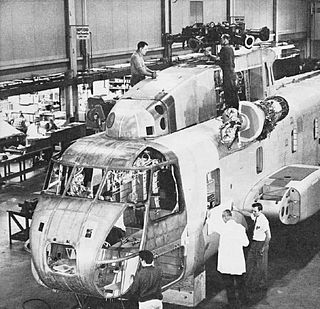Westland Aircraft was a British aircraft manufacturer located in Yeovil, Somerset. Formed as a separate company by separation from Petters Limited just before the start of the Second World War, Westland had been building aircraft since 1915. During the war the company produced a number of generally unsuccessful designs, but their Lysander would serve as an important liaison aircraft with the Royal Air Force. After the war the company focused on helicopters, and was merged with several other British firms to create Westland Helicopters in 1961.

The AgustaWestland AW101 is a medium-lift helicopter in military and civil use. First flown in 1987, it was developed by a joint venture between Westland Helicopters in the United Kingdom and Agusta in Italy in response to national requirements for a modern naval utility helicopter. Several operators, including the armed forces of Britain, Denmark, and Portugal, use the name Merlin for their AW101 aircraft. It is manufactured at factories in Yeovil, England, and Vergiate, Italy. Licensed assembly work has also taken place in Japan and the United States.

The AgustaWestland CH-149 Cormorant is the Canadian Forces designation for the AgustaWestland AW101, a helicopter used for air-sea rescue in Canada. Developed from AgustaWestland in Italy, the CH-149 is a medium-lift helicopter for military applications.

Agusta was an Italian helicopter manufacturer. It was based in Samarate, Northern Italy. The company was founded by Count Giovanni Agusta in 1923, who flew his first airplane in 1907. The MV Agusta motorcycle manufacturer began as an offshoot of the Agusta aviation company at the end of the Second World War, as a means to save the jobs of employees of the Agusta firm.

AgustaWestland was an Anglo-Italian helicopter design and manufacturing company, which was a wholly owned subsidiary of Finmeccanica. It was formed in July 2000 as an Anglo-Italian multinational company, when Finmeccanica and GKN merged their respective helicopter subsidiaries to form AgustaWestland, with each holding a 50% share. Finmeccanica acquired GKN's stake in AgustaWestland in 2004.

Leonardo S.p.A., formerly Leonardo-Finmeccanica and originally Finmeccanica, is an Italian multinational company specialising in aerospace, defence and security. Headquartered in Rome, Italy, the company has 180 sites worldwide. It is the 12th largest defence contractor in the world based on 2020 revenues. The company is partially owned by the Italian government, which holds 30.2% of the company's shares and is its largest shareholder.
Saunders-Roe Limited, also known as Saro, was a British aero- and marine-engineering company based at Columbine Works, East Cowes, Isle of Wight.

The Helicopter Museum in Weston-super-Mare, North Somerset, England, is a museum featuring a collection of more than 80 helicopters and autogyros from around the world, both civilian and military. It is based at the southeastern corner of the former Weston-super-Mare Airport and is the largest collection of helicopters in the world.

The Lockheed Martin VH-71 Kestrel was a variant of the AgustaWestland AW101 that was being manufactured to replace the United States Marine Corps' Marine One U.S. Presidential transport fleet. Originally marketed for various competitions as the US101, it was developed and manufactured in the US by a consortium headed by Lockheed Martin, consisting of Lockheed Martin Systems Integration – Owego (LMSI), AgustaWestland and Bell Helicopter.

700 Naval Air Squadron is an experimental test squadron in the Royal Navy’s Fleet Air Arm.

The Alvis Leonides is a British air-cooled nine-cylinder radial aero engine first developed by Alvis Car and Engineering Company in 1936.

The Westland Westminster was a British helicopter of the 1950s from Westland Aircraft. A large cargo design, it was powered by two turboshaft engines driving a single, five-bladed rotor. Initially unclad, the all-metal airframe was later enclosed in a fabric covering. Designed and built as a private venture without government assistance, it was cancelled when Westland took over rival helicopter producers and their more advanced projects.
FPT Industries was formed in July 1939 as Fireproof Tanks Ltd as a subsidiary of Airspeed Ltd at Portsmouth Airport in response to an Air Ministry requirement for the development and manufacture of self-sealing fuel tanks for the impending war with Germany.

British Airways Helicopters was a British helicopter airline from 1964 to 1986.

705 Naval Air Squadron was first formed as a flight in 1936 from No 447 Flight Royal Air Force and operated Swordfish torpedo bombers from battlecruisers. It achieved squadron status in 1939 before being disbanded in 1940. The squadron was re-formed briefly in 1945 and then again in 1947 as a fleet requirements unit to evaluate naval use of helicopters. Since the 1950s the squadron has been involved in the basic training of helicopter aircrew, and currently forms part of No. 1 Flying Training School at RAF Shawbury.

The AgustaWestland AW159 Wildcat is a military helicopter, developed by the British-Italian helicopter manufacturer AgustaWestland, and later marketed by the Italian aerospace company Leonardo. It is an improved version of the Westland Super Lynx designed to serve in the battlefield utility, search and rescue, aerial reconnaissance, anti-submarine warfare (ASW), anti-surface warfare (ASuW), utility, command and control, and troop transport duties.

Helicopter manufacturers belong to the broader category of aerospace manufacturers. It is useful to think of helicopter manufacturers as falling into two categories, those that can design, certify and manufacture new helicopter designs from scratch and those that can only manufacture extant designs under license. Boeing Vertol is an example of the first type and Kawasaki Heavy Industries, who license-produced Boeing Vertol designs for much of its recent history, is an example of the second type.



















